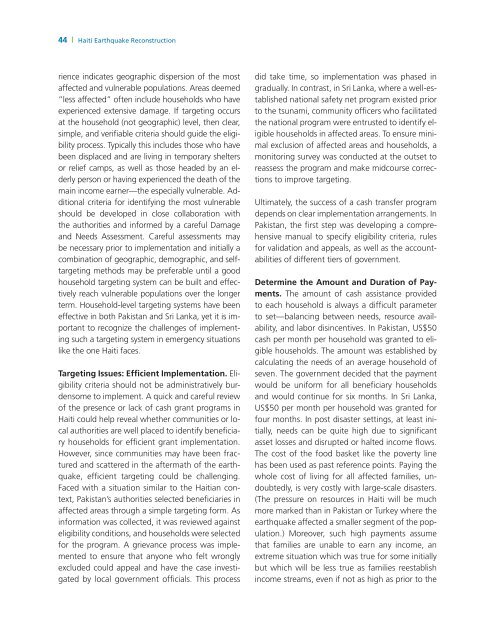Haiti Earthquake Reconstruction Knowledge Notes from ... - GFDRR
Haiti Earthquake Reconstruction Knowledge Notes from ... - GFDRR
Haiti Earthquake Reconstruction Knowledge Notes from ... - GFDRR
You also want an ePaper? Increase the reach of your titles
YUMPU automatically turns print PDFs into web optimized ePapers that Google loves.
44 | <strong>Haiti</strong> <strong>Earthquake</strong> <strong>Reconstruction</strong><br />
rience indicates geographic dispersion of the most<br />
affected and vulnerable populations. Areas deemed<br />
“less affected” often include households who have<br />
experienced extensive damage. If targeting occurs<br />
at the household (not geographic) level, then clear,<br />
simple, and verifiable criteria should guide the eligibility<br />
process. Typically this includes those who have<br />
been displaced and are living in temporary shelters<br />
or relief camps, as well as those headed by an elderly<br />
person or having experienced the death of the<br />
main income earner—the especially vulnerable. Additional<br />
criteria for identifying the most vulnerable<br />
should be developed in close collaboration with<br />
the authorities and informed by a careful Damage<br />
and Needs Assessment. Careful assessments may<br />
be necessary prior to implementation and initially a<br />
combination of geographic, demographic, and selftargeting<br />
methods may be preferable until a good<br />
household targeting system can be built and effectively<br />
reach vulnerable populations over the longer<br />
term. Household-level targeting systems have been<br />
effective in both Pakistan and Sri Lanka, yet it is important<br />
to recognize the challenges of implementing<br />
such a targeting system in emergency situations<br />
like the one <strong>Haiti</strong> faces.<br />
Targeting Issues: Efficient Implementation. Eligibility<br />
criteria should not be administratively burdensome<br />
to implement. A quick and careful review<br />
of the presence or lack of cash grant programs in<br />
<strong>Haiti</strong> could help reveal whether communities or local<br />
authorities are well placed to identify beneficiary<br />
households for efficient grant implementation.<br />
However, since communities may have been fractured<br />
and scattered in the aftermath of the earthquake,<br />
efficient targeting could be challenging.<br />
Faced with a situation similar to the <strong>Haiti</strong>an context,<br />
Pakistan’s authorities selected beneficiaries in<br />
affected areas through a simple targeting form. As<br />
information was collected, it was reviewed against<br />
eligibility conditions, and households were selected<br />
for the program. A grievance process was implemented<br />
to ensure that anyone who felt wrongly<br />
excluded could appeal and have the case investigated<br />
by local government officials. This process<br />
did take time, so implementation was phased in<br />
gradually. In contrast, in Sri Lanka, where a well-established<br />
national safety net program existed prior<br />
to the tsunami, community officers who facilitated<br />
the national program were entrusted to identify eligible<br />
households in affected areas. To ensure minimal<br />
exclusion of affected areas and households, a<br />
monitoring survey was conducted at the outset to<br />
reassess the program and make midcourse corrections<br />
to improve targeting.<br />
Ultimately, the success of a cash transfer program<br />
depends on clear implementation arrangements. In<br />
Pakistan, the first step was developing a comprehensive<br />
manual to specify eligibility criteria, rules<br />
for validation and appeals, as well as the accountabilities<br />
of different tiers of government.<br />
Determine the Amount and Duration of Payments.<br />
The amount of cash assistance provided<br />
to each household is always a difficult parameter<br />
to set—balancing between needs, resource availability,<br />
and labor disincentives. In Pakistan, US$50<br />
cash per month per household was granted to eligible<br />
households. The amount was established by<br />
calculating the needs of an average household of<br />
seven. The government decided that the payment<br />
would be uniform for all beneficiary households<br />
and would continue for six months. In Sri Lanka,<br />
US$50 per month per household was granted for<br />
four months. In post disaster settings, at least initially,<br />
needs can be quite high due to significant<br />
asset losses and disrupted or halted income flows.<br />
The cost of the food basket like the poverty line<br />
has been used as past reference points. Paying the<br />
whole cost of living for all affected families, undoubtedly,<br />
is very costly with large-scale disasters.<br />
(The pressure on resources in <strong>Haiti</strong> will be much<br />
more marked than in Pakistan or Turkey where the<br />
earthquake affected a smaller segment of the population.)<br />
Moreover, such high payments assume<br />
that families are unable to earn any income, an<br />
extreme situation which was true for some initially<br />
but which will be less true as families reestablish<br />
income streams, even if not as high as prior to the

















